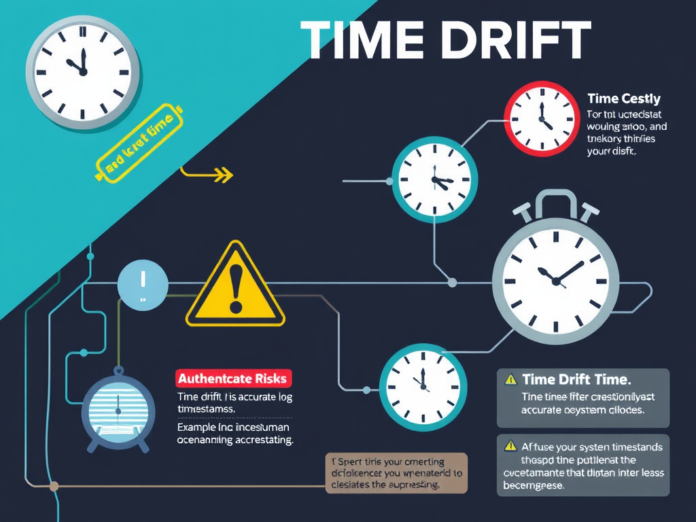Cybersecurity teams often focus on major threats, such as malware, phishing, and ransomware. But one small, easily overlooked issue can open serious security gaps: time drift. In simple terms, time drift happens when a system’s internal clock becomes inaccurate. While a few seconds might not sound like much, even tiny timing issues can cause big cybersecurity problems. In this article, we’ll explain how time drift happens, why it matters in cybersecurity, and how to keep your clocks aligned to avoid costly mistakes.

What Is Time Drift?
Time drift refers to the gradual loss of accuracy in a device or system’s clock. Every computer or server has an internal clock. Over time, that clock can slowly fall out of sync with real-world time, especially if it’s not connected to a trusted external source, such as a network time server.
Common causes of time drift include:
- Hardware design limitations
- Power interruptions or fluctuations
- Environmental conditions like temperature
- Infrequent synchronisation with a reliable time source
Over days or weeks, time drift can cause different systems to disagree on what time it is, leading to confusion and even security failures.
Why Time Drift Is a Security Concern
System time isn’t just a background setting. It plays a key role in critical areas of cybersecurity. Here’s how time drift can cause real harm:
- Inaccurate Log Timestamps
Cybersecurity analysts rely on logs to investigate incidents. If time drift causes one system to record events minutes earlier than another, tracking down threats becomes harder. - Broken Encryption and Certificates
Time drift can interfere with SSL/TLS certificates. If the system clock is too far off, valid certificates might appear expired or rejected entirely, disrupting secure communications. - Authentication Failures
Protocols like Kerberos use timestamps to verify identity. If the server and client are out of sync, even valid login attempts can fail. - Missed or False Security Alerts
Security tools track behaviour over time. If timestamps are incorrect, alerts can be triggered too late or not at all.
In each case, a misaligned clock can create openings for attackers or cause your team to miss red flags.
Time Drift in the Real World
Time-related issues have caused real-world disruptions:
- Amazon Web Services (AWS) faced a service issue when server clocks drifted, impacting security token generation.
- Financial institutions must keep precise time for compliance. Time errors can cause transaction mismatches and violations.
- Forensics teams may misinterpret evidence due to inconsistent log times across devices.
These problems are not theoretical—they’re happening now.
How to Detect and Fix Time Drift
Managing time drift doesn’t require expensive tools, but it does require discipline. Here’s how to stay ahead:
- Sync with NTP Servers – Use trusted Network Time Protocol (NTP) servers to keep your system clocks up to date regularly.
- Set Internal Time Sources – In enterprise environments, set up your own centralised time server.
- Use Hardware with Reliable Clocks – Choose systems with high-quality real-time clocks (RTC).
- Enable Monitoring – Many SIEM and monitoring tools can flag timestamp inconsistencies.
- Avoid Manual Changes – Let synchronisation software manage time instead of making manual adjustments.
Best Practices for Time Sync in Security
- Configure time sync during initial system setup.
- Verify that all security tools (firewalls, antivirus, SIEM) are using the same time source.
- Use secure NTP services that verify the authenticity of the source.
- Schedule frequent checks to confirm accurate time.
- Document all timekeeping practices in your security policy.
Compliance Considerations
Regulatory frameworks like:
- HIPAA
- PCI-DSS
- ISO 27001
…all require reliable logs for incident response and audits. Inconsistent timestamps due to time drift can put your organisation at risk of non-compliance. Auditors look for clean, synchronised logs. Time drift can be viewed as control failures since it causes overlaps or voids.
READ MORE – Throttling Cybersecurity: Balancing Network Speed and Security
FAQs:
- What degree of drift is tolerable?
Usually, systems should remain within a few milliseconds of a reliable time source. - Is time drift exploitable in an attack?
Certainly. Hackers can spoof tokens or avoid detection by using timing disparities. - Does time drift cause more problems in virtual machines?
Yes, it can exacerbate synchronisation issues in virtual environments. - What tools help correct time drift?
NTP clients, such as Chrony on Linux and the Windows Time Service, are common tools. - Should cloud systems use the same NTP source?
Absolutely. It ensures consistent logs and better incident response coordination.
Conclusion:
Time might not make headlines like main cyberattacks, but it plays a concealed, dangerous role in how systems stay safe. It’s a crucial part of your cybersecurity posture. Without reliable timing, even the best security schemes lose their advantage. Fixing time drift is simple—use network time synchronisation, monitor frequently, and keep all systems aligned. It’s a low-effort, high-impact improvement that protects logs, encryption, and access control. In cybersecurity, timing isn’t just everything, it’s the first line of defence.



